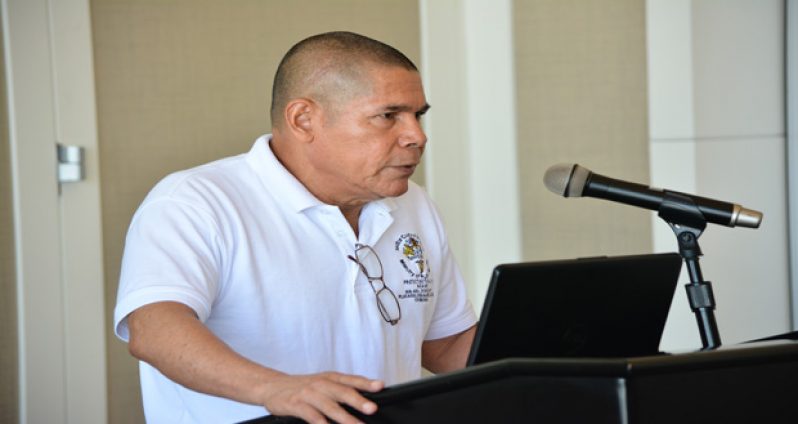IN light of the troubling problem of suicide, stakeholders — including ministries, religious bodies, non-governmental organisations (NGOs) and international bodies — yesterday commenced deliberating on possible ways of arresting the situation.The meeting at the Marriott Hotel attracted several ministers of Government, and the National Suicide Prevention Plan 2015-2020 was presented by Dr Bhiro Harry, Head of the Ministry of Public Health’s Mental Health Unit.
Guyana has been ranked as having the highest suicide rate relative to its population, by a World Health Organisation (WHO) report in 2014. Against that background, the suicide prevention strategy aims to “reduce the incidence of attempted suicide and suicide mortality by more than 50 per cent, thereby preventing premature death from suicide or morbidity (and) disability from attempted suicide across the lifespan.”
The 50 per cent range, according to Dr Harry, was chosen because it is a realistic target which could be achieved once the proposed plans are executed successfully.

The line of action proposed in the document, which was presented last year, includes risk factors’ reduction; health promotion; and prevention of suicidal behaviour; reduction of access to the means of suicide; health system response to suicidal behaviour; and suicide surveillance and research.
EMERGENCY ACTION PLAN
Dr Harry also highlighted the emergency action plan which seeks to restrict access to the means of suicide; awareness about suicide prevention; responsible media reporting; training; increased access to mental health facilities; and importantly, follow-up and community support.
The Mental Health Unit head also related that while there is always a need for facilities and resources, including human resource, authorities must work with what is currently in their employ and utilise those to their fullest potential.
“We are currently training people… and this training is not only for persons in the medical field. The training cannot be limited to Public Health employees. We must go into communities, schools and offices and teach villagers, parents and employees how to respond and communicate with persons [who have suicidal thoughts]” Dr Harry said.
And supporting this view, which underscores the role of the community and other domestic institutions, was Minister of Health, Dr. George Norton, who also emphasized that the onus of suicide prevention is not limited to medical officers.
According to the Minister, the escalating number of cases of suicide in Guyana has prompted a more immediate response mechanism which seeks to reduce the number of cases of suicide presently being recorded.
He noted that help and advice has been pouring in from all over, even from foreign countries which are concerned about the growing numbers; but, because of the complexity of suicide prevention, he noted, the approach has to be a strategic one which will avoid making the situation worse.
FAMILY AND COMMUNITY SUPPORT
And while the population, as a natural reaction, looks to the Government for a solution to national issues such as suicide, Minister Norton underscored the role of the family and community in providing support for persons suffering with suicidal thoughts.
He noted, however, that the role of the family and community will by no means diminish the involvement of the Government, which will continue to lead the way in providing solutions to tackle this issue.
Chief Medical Officer (CMO), Dr. Shamdeo Persaud, also made a presentation at the meeting, highlighting the fact that a detailed analysis in Guyana over the last five years has indicated that most of the cases are concentrated in coastal areas of the country.
Region Six recorded 30.9 per cent, Region Three 22 per cent, Region Four 19.7 per cent, and Region Two 12.4 per cent. Regions One, Seven, Eight and Nine accounted for just over four per cent of the cases, but the recent evidence, according to Dr Persaud, indicates that this figure may be higher.
Additionally, he noted that East Indians accounted for 80 per cent of cases of suicide, with males from this ethnic group accounting for 66 per cent of all cases.
Persons of mixed ancestry accounted for just fewer than 10 per cent, with Africans (5 per cent) and Indigenous people (5 per cent) being less frequently suicide victims.
Also present at the meeting yesterday were Minister of Indigenous People’s Affairs, Sydney Allicock, and Minister within the Ministry of Indigenous People’s Affairs, Valarie Garrido-Low; Minister of Telecommunications, Cathy Hughes; Minister within the Ministry of Health, Dr Karen Cummings; Minister within the Ministry of Education, Nicolette Henry; Minister of Social Protection, Volda Lawrence; representatives of the Pan American Health Organization and World Health Organization (PAHO/WHO) and the United Nations Children’s Fund (UNICEF); representatives from the Ministry of Agriculture, non- governmental organisations (NGO) and religious organisations.
If you, or anyone you know, are experiencing suicidal thoughts, speak to a family member or leader in your community, or call the suicide helpline on telephone numbers: (+592) 223-0001, 223-0009, 600-7896, 623-4444. Say yes to life! (rsingh@guyanachronicle.com)












